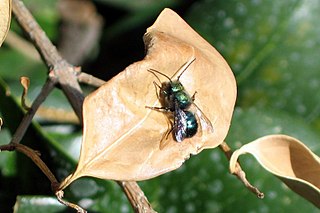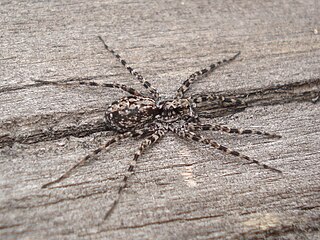
Pollination of fruit trees is required to produce seeds with surrounding fruit. It is the process of moving pollen from the anther to the stigma, either in the same flower or in another flower. Some tree species, including many fruit trees, do not produce fruit from self-pollination, so pollinizer trees are planted in orchards.

Powelliphanta is a genus of large, air-breathing land snails, pulmonate gastropods in the family Rhytididae, found only in New Zealand. They are carnivorous, eating invertebrates, mostly native earthworms. Often restricted to very small areas of moist forest, they are prey to introduced mammalian predators, and many species are threatened or endangered.

Mason bee is a name now commonly used for species of bees in the genus Osmia, of the family Megachilidae. Mason bees are named for their habit of using mud or other "masonry" products in constructing their nests, which are made in naturally occurring gaps such as between cracks in stones or other small dark cavities; when available some species preferentially use hollow stems or holes in wood made by wood-boring insects.

Osmia lignaria, commonly known as the orchard mason bee or blue orchard bee, is a megachilid bee that makes nests in reeds and natural holes, creating individual cells for its brood that are separated by mud dividers. Unlike carpenter bees, it cannot drill holes in wood. O. lignaria is a common species used for early spring fruit bloom in Canada and the United States, though a number of other Osmia species are cultured for use in pollination.

Powelliphanta lignaria, known as one of the amber snails, is a species of large, carnivorous land snail, a terrestrial pulmonate gastropod mollusc in the family Rhytididae. The eggs of P. lignaria are oval and seldom constant in dimensions 10 × 8.25, 9 × 7.75, 9 × 8, 8.75 × 7.75 mm.

Tulip snail, or Tulip shell is the common name for two or three species of large, predatory, subtropical and tropical sea snails from the Western Atlantic. These species are in the genus Fasciolaria. They are marine gastropod mollusks in the family Fasciolariidae, the spindle shells, tulip shells and their allies.
The carpenter's chimaera, also known as the giant chimaera or the giant purple chimaera, is a species of fish in the family Chimaeridae.
Dolichesia is a genus of moths in the subfamily Arctiinae.
Osmia californica is a megachilid bee, or mason bee. Native to North America, the mason bees are important pollinators. O. californica generally emerges a little later in the spring than the better known orchard mason bee. Like the orchard mason bee, O. californica is a solitary nester.

Chimaera is the type genus of the cartilaginous fish family Chimaeridae.
Cytora lignaria is a species of very small land snails with an operculum, terrestrial gastropod molluscs in the family Pupinidae.
Avirostrum is a genus of moths of the Noctuidae family.

Probithia exclusa is a moth of the family Geometridae. It is found in the north-eastern Himalaya, Sri Lanka, the Philippines, Sulawesi and Sundaland.

Drillia lignaria is a species of sea snail, a marine gastropod mollusk in the family Drilliidae.

Tarantinaea lignaria is a species of sea snail, a marine gastropod mollusk in the family Fasciolariidae, the spindle snails, the tulip snails and their allies.

Acantholycosa lignaria is a species of wolf spiders. It is a widespread species of central and northern Europe.
Nyssodrysina is a genus of beetles in the family Cerambycidae, containing the following species:

Tarantinaea is a genus of sea snails, marine gastropod mollusks in the family Fasciolariidae, the spindle snails, the tulip snails and their allies.
Nyssodrysina lignaria is a species of beetle in the family Cerambycidae. It was described by Bates in 1864.












